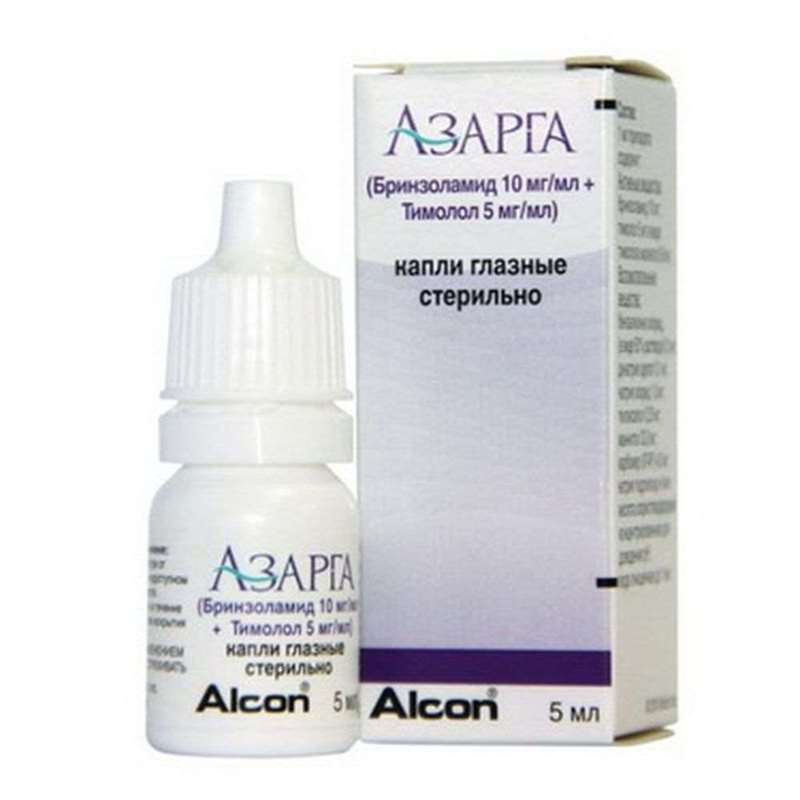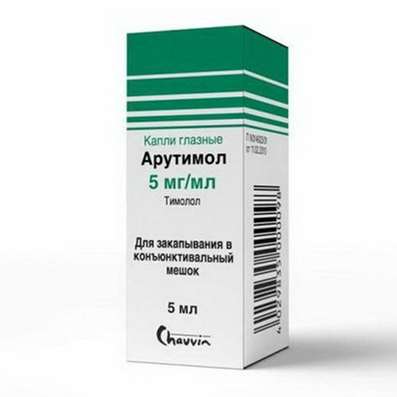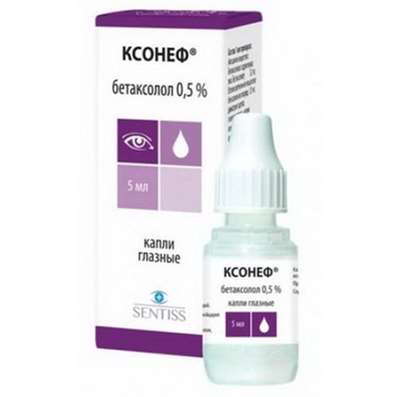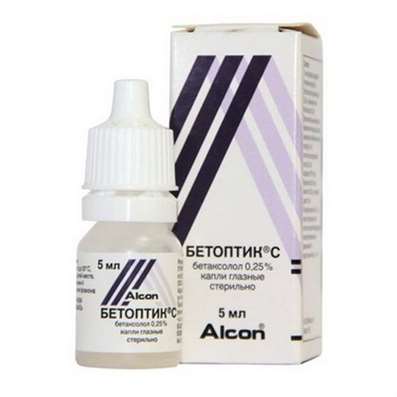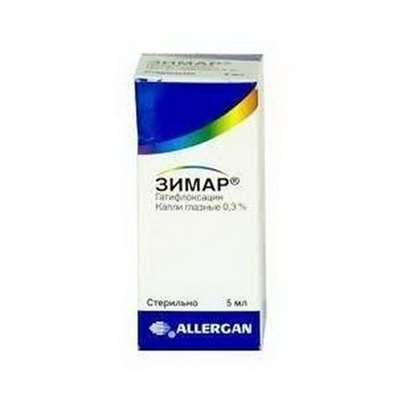Azarga eye drops – combined preparation for the treatment of open-angle glaucoma and ocular hypertension, reduce elevated intraocular pressure by reducing the production of intraocular fluid.
Brinzolamide is an inhibitor of carbonic anhydrase II. Due to inhibition of carbonic anhydrase II, the formation of bicarbonate ions slows down, followed by a decrease in the transport of sodium and liquid, which leads to a decrease in the production of intraocular fluid in the ciliary body of the eye. As a result, there is a decrease in intraocular pressure (IOP).
Timolol is a non-selective beta-adrenergic blocker without sympathomimetic activity, does not have a direct depressive effect on the myocardium, does not have membrane-stabilizing activity. With topical application reduces intraocular pressure by reducing the formation of watery moisture and a slight increase in its outflow.
The combined action of Brinzolamide and Timolol exceeds the effect of each substance separately.
Pharmacokinetics
With topical application, brinzolamide and timolol penetrate the systemic bloodstream. Brinzolamide is absorbed in erythrocytes as a result of selective binding mainly with carbonic anhydrase II. Cmax of brinzolamide in erythrocytes is about 18.4 μM. The binding with plasma proteins is about 60%.
The metabolism of Brinzolamide occurs by N-dealkylation, O-dealkylation and oxidation of the N-propyl side chain. The main metabolite, N-desethylbenzenamide, binds predominantly to carbonic anhydrase I in the presence of Brinzolamide and also accumulates in red blood cells. In vitro studies show that the benzoamide metabolism is mainly responsible for the isoenzyme CYP3A4, as well as the isozymes CYP2A6, CYP2B6, CYP2C8 and CYP2C9. Brinzolamide is excreted mainly by the kidneys in an unchanged form - about 60%. About 20% is excreted in the form of metabolites: the main metabolite (N-desethylbenzenamide) and trace concentrations of other metabolites (N-demethoxypropyl and O-desmethyl).
Cmax of timolol in blood plasma is about 0.824 ng / ml and remains until the detection threshold for 12 h. T1 / 2 timolol is 4.8 h after topical application of Azarga. The metabolism of timolol occurs in two ways: with the formation of an ethanolamine side chain on the thiadiazole ring and with the formation of an ethanol side chain in morpholine nitrogen and a similar side chain with a carbonyl group connected to nitrogen. Metabolism of timolol is mainly carried out by the isoenzyme CYP2D6. Timolol and the resulting metabolites are mainly excreted by the kidneys. About 20% of timolol is excreted unchanged, the rest - in the form of metabolites.
Indications:
Decrease in increased intraocular pressure in open-angle glaucoma and intraocular hypertension in patients in whom monotherapy was insufficient to reduce intraocular pressure.
Contraindications:
- bronchial asthma (including in the anamnesis);
- chronic obstructive pulmonary disease of severe course;
- hyperreactivity of the bronchi;
- sinus bradycardia;
- AV-blockade II-III degree;
- severe heart failure;
- cardiogenic shock;
- allergic rhinitis of severe course;
- severe renal failure (creatinine clearance <30 mL / min);
- angle-closure glaucoma;
- simultaneous use with oral inhibitors of carbonic anhydrase;
- pregnancy;
- lactation period;
- children's age till 18 years;
- hypersensitivity to the group of beta-blockers, hyperchloremic acidosis;
- hypersensitivity to sulfonamides;
- hypersensitivity to the components of the drug.
With caution: patients with hyperthyroidism, Prinzmetal angina, peripheral and central circulation disorders and arterial hypotension.
The experience of using Azarga for the treatment of patients with pseudoexfoliation glaucoma, pigmentary glaucoma is limited: in these cases, use the drug with caution and constantly monitor the intraocular pressure.
Anaphylactic reactions. Patients with atopy or with severe anaphylactic reactions to various allergens in a history who receive beta-blockers may be resistant to conventional doses of epinephrine in the treatment of anaphylactic reactions.
System effects. Brinzolamide and timolol can undergo systemic absorption. Timolol with local use can cause the same side effects from the cardiovascular and respiratory systems, as well as systemic beta-blockers. It is necessary to monitor the patient's condition before and during therapy with timolol. Cases of severe respiratory and cardiovascular disorders, including death from bronchospasm in patients with bronchial asthma and death from heart failure with timolol, are described.
Beta-blockers should be used with caution in patients with a tendency to hypoglycemia or diabetes (especially with diabetes mellitus), because these drugs can mask the symptoms of acute hypoglycemia.
Prior to the planned operation, beta-blockers should be gradually (not simultaneously) canceled 48 hours before the general anesthesia, tk. during general anesthesia, they can reduce the sensitivity of the myocardium to sympathetic stimulation, the necessary day of the heart.
Azarga contains Brinzolamide, which is a sulfonamide. Because with topical application, systemic absorption of the drug takes place, side reactions typical for sulfonamides may occur. The development of a violation of acid-base balance with the use of oral forms of inhibitors of carbonic anhydrase is described.
Special instructions:
In older patients, carbonic anhydrase inhibitors administered orally may affect the ability to engage in activities requiring increased attention or coordination. This effect should be considered when assigning Azarga, tk. at local application the preparation gets into the systemic bloodstream.
When using brinzolamide in patients wearing contact lenses, the condition of the cornea should be monitored, as inhibitors of carbonic anhydrase can lead to a violation of its hydration. It is recommended that patients with corneal abnormalities, diabetes mellitus, or corneal dystrophy be closely monitored.
Benzalkonium chloride, which is part of the Azarga preparation, can cause point keratopathy and / or toxic ulcer keratopathy. With prolonged use of the drug, careful monitoring of patients is recommended. Benzalkonium chloride can be absorbed by contact lenses. Before using the drug, the lenses should be removed and installed back no earlier than 15 minutes after the drug is used.
Do not touch the tip of the dropper bottle to any surface to avoid contamination of the dropper and its contents. The bottle must be closed after each use.
Impact on the ability to drive vehicles and manage mechanisms
After applying the drug, vision sharpness may temporarily decrease, and it is not recommended to drive and engage in activities requiring increased attention before recovery.
In case of violations of kidney function
The drug is contraindicated in severe renal failure (creatinine clearance less than 30 ml / min).
Application in old age
In older patients, carbonic anhydrase inhibitors administered orally may affect the ability to engage in activities requiring increased attention or coordination. This effect should be considered when assigning Azarga, tk. at local application the preparation gets into the systemic bloodstream.
Suggested Use:
Locally. Vial before use shake.
1 drop in the conjunctival sac of the eye 2 times / day.
After applying the drug to reduce the risk of systemic side effects, it is recommended to lightly press the finger onto the projection area of lacrimal sacs at the inner corner of the eye within 1-2 minutes after the drug is installed - this reduces the systemic absorption of the drug.
If the dose was missed, the treatment should be continued from the next dose on schedule. The dose should not exceed 1 drop in the conjunctival sac of the eye 2 times / day.
If you replace an antiglaucoma drug with Azarga, you should start using Azarga the day after the previous drug was discontinued.
Packaging:
- Comes in original packaging. Item is brand new and unopened.
Storage:
- Keep away from direct sunlight.
- Keep locked and away from children.
- Store in dry place at room temperature.
- Do not exceed storage temperature higher than 25 C
Important notice- the outer box design may vary before prior notice!

 Cart
Cart
